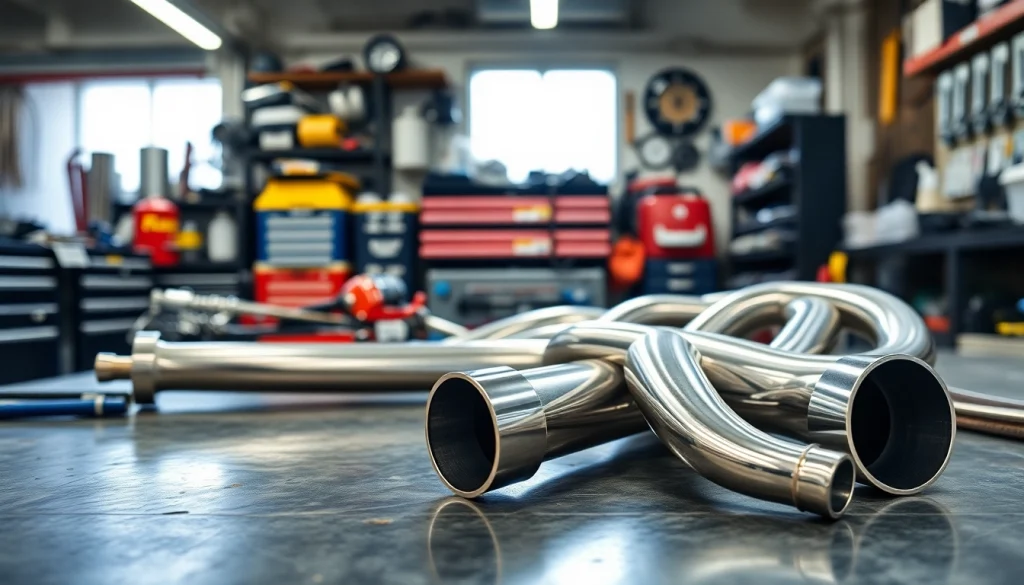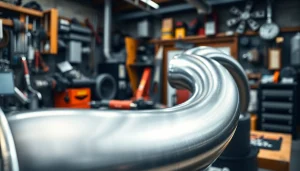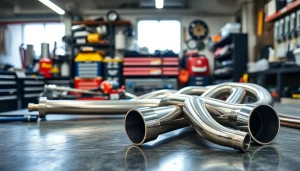Enhancing Vehicle Performance with High-Quality Charge Piping Solutions

Understanding Charge Piping
What are Charge Piping and its Functions?
Charge piping is a crucial component in various automotive applications, notably in turbocharged vehicles. Essentially, charge piping refers to the network of pipes that directs compressed air from the turbocharger to the engine’s intake manifold and, intermittently, directs fresh air into the turbocharger from the engine. The principal function of charge piping is to facilitate the efficient movement of airflow, enhancing overall engine performance and throttle response.
When air is compressed, it becomes hotter. Charge piping must withstand high temperatures and pressures, making the choice of material and design fundamental to its efficiency. By optimizing airflow, charge piping helps prevent turbo lag, allowing for quicker throttle response and improved power delivery. An effective charge piping system contributes significantly to a vehicle’s ability to maintain performance under varying driving conditions.
For detailed insights into various systems, check out this source on charge piping solutions and innovations in automotive engineering.
Components and Materials of Charge Piping
Charge piping systems typically consist of several key components, including:
– Pipes: These are often made of aluminum, stainless steel, or high-quality silicone. Aluminum and stainless steel are favored for their strength and ability to withstand extreme temperatures and pressures, while silicone is used for flexibility in various angles and bends within the system.
– Hoses and Couplers: Hoses connect the charge pipes to various engine components. Silicone hoses are commonly employed due to their high thermal resistance and flexibility. Couplers are essential for connecting different sections of piping and ensuring a tight, leak-free seal.
– Intercoolers: While technically separate from charge piping, intercoolers accompany charge piping systems, cooling the compressed air before it enters the engine. This cooling process increases density, which can significantly enhance engine performance.
Properly designed charge piping minimizes restrictions and turbulence, optimizing airflow. Therefore, the choice of materials and components is paramount. For example, stainless steel pipes with a smooth interior surface reduce friction and improve airflow compared to traditional rubber hoses.
How Charge Piping Affects Vehicle Performance
The performance impact of charge piping cannot be underestimated. Effective charge piping enhances airflow to the engine, which translates to several performance benefits:
– Boost Pressure Retention: Charge piping must effectively retain boost pressure to prevent losses during acceleration. Quality charge piping minimizes pressure drops caused by inefficiencies in the system.
– Thermal Management: As mentioned, cooler air enhances performance. Charge piping equipped with heat-resistant properties can significantly decrease the temperature of the air entering the engine, thereby improving combustion efficiency.
– Turbo Lag Reduction: A well-designed charge piping system allows air to flow more freely into the intake manifold, reducing turbo lag. This responsiveness is essential for performance driving and everyday vehicle operation.
– Improved Throttle Response: Direct and unobstructed airflow increases engine response to accelerator inputs. This improvement provides a more engaging driving experience and can lead to better handling in performance-oriented applications.
Through these mechanisms, it’s clear that charge piping is a foundational element in optimizing engine performance.
The Benefits of Upgrading Charge Piping
Upgrading charge piping can yield substantial improvements in vehicle performance. The decision to do so often hinges on several key benefits.
Increased Airflow for Better Engine Efficiency
One of the primary reasons for upgrading charge piping is the resultant increase in airflow. Factory-installed piping is often restrictive in nature, designed more for cost-efficiency than performance. By installing upgraded charge piping, enthusiasts frequently experience a marked improvement in airflow, leading to better overall engine efficiency.
– Enhanced Air Pathways: Upgraded piping often has larger diameter tubes that facilitate quicker air transfer. This enhancement ensures that the engine receives ample air for optimal combustion.
– Streamlined Designs: Curved and janky factory pipes may disrupt airflow, creating turbulence. Aftermarket charge piping is often designed with smoother bends and transitions, further optimizing airflow into the engine.
Enhanced Durability and Performance Reliability
Factory charge piping systems may be made from lower-grade materials that can degrade over time due to heat and pressure. Upgrading to high-quality materials, such as reinforced silicone or aluminum, enhances durability and resistance to failure under stress.
– Reduced Risk of Cracks and Leaks: With improved materials, the risk of cracks arising from thermal expansion or pressure is significantly reduced. Consequently, the performance reliability of the engine is bolstered.
– Longer Lifespan: Investing in quality charge piping ensures a longer lifespan, reducing the frequency of potential repairs or replacements.
Improved Throttle Response and Power Delivery
Upgraded charge piping directly associates with improved throttle response. This enhancement comes from a more efficient airflow trajectory to the engine.
– Faster Boost Build-Up: As the turbo receives and processes air more efficiently, the time taken to build boost is significantly reduced.
– Smoother Power Band: Many drivers report a more linear power delivery with upgraded charge piping, enhancing the overall driving experience and offering more predictability and control during acceleration.
The benefits of upgraded charge piping contribute to not only enhanced performance but also increased driver satisfaction and confidence.
Installing Charge Piping: Best Practices
Installing new charge piping can seem daunting, but with the right approach, it can be both manageable and rewarding.
Essential Tools and Materials Required
Before diving into the installation process, it’s vital to prepare adequately. Here’s a checklist of essential tools and materials:
– High-quality charge piping kit, inclusive of pipes, hoses, couplers, and necessary installation hardware.
– Basic hand tools (screwdrivers, pliers, wrenches).
– A torque wrench for securely tightening connections.
– Zip ties for organizing hoses.
– Cleaning supplies for prep work.
– An intake air temp sensor, if applicable for modifications.
Proper preparation helps streamline the installation process, reducing potential complications.
Step-by-Step Installation Guide
Follow these steps for a successful charge piping installation:
1. Preparation: Begin by disconnecting the vehicle battery and removing any obstructions that might hinder access to the charge piping area (like air intake components).
2. Remove Old Charge Pipes: Carefully detach the existing piping, taking note of how each section connects. This will serve as a reference when installing new piping.
3. Install the New Charge Pipes: Start from the turbocharger, working your way towards the intake manifold. Ensure that all couplers and connections are secure but avoid overtightening, which can damage the components.
4. Reconnect Components: Once the new piping is in place, reconnect any components removed during the disassembly.
5. Test Fit: Before finalizing the connections, make sure that everything fits correctly and securely, checking for any potential obstructions.
6. Reattach the Battery: After confirming the integrity of the installation, reconnect the battery and conduct a brief air pressure test to ensure there are no leaks in your new charge piping system.
7. Final Inspection: Take a moment to inspect all installations and ensure good clearance with surrounding parts.
Common Mistakes to Avoid During Installation
While installing charge piping is generally straightforward, it’s easy to make mistakes that could lead to performance issues:
– Failing to Insulate Pipes: Heat transfer occurs, causing the charge air to heat up. Ensure pipes are insulated where necessary to maintain optimal temperatures.
– Neglecting Vacuum Leaks: Before finalizing the installation, carefully check all connections for potential air leaks. A small gap can reduce performance significantly.
– Ignoring Manufacturer Instructions: Each charge piping kit may come with specific instructions or recommendations. Ignoring them can lead to improper installation and potential performance losses.
By following these best practices, the installation of charge piping can yield significant performance benefits for the vehicle.
Choosing the Right Charge Piping for Your Vehicle
The efficacy of charge piping heavily depends not just on installation but also on selecting the right components for your vehicle’s needs.
Different Types of Charge Piping on the Market
Charge piping options vary widely, tailored to different vehicle types and performance needs. Here’s a look at some of the most common types:
– Aluminum Charge Pipes: These are very popular due to their lightweight and strength. They withstand high pressures and temperatures well, which is perfect for performance applications.
– Silicone Hose Kits: For those looking for flexibility in installation or replacement, silicone hoses can be an excellent choice. Resilient against cracking, they can often bend and maneuver around cramped engine layouts.
– Turbo Inlet Pipes: Tuning enthusiasts often consider turbo inlet upgrades, which can maximize airflow from the intake side, further enhancing the effectiveness of the charge piping.
Factors to Consider When Making a Selection
When selecting charge piping, several factors should be on your checklist:
– Vehicle Compatibility: Ensure that the piping is specifically designed for your vehicle make and model. Fitment issues can lead to performance losses and installation difficulties.
– Performance Goals: Consider the intended use of your vehicle. For high-performance applications, investing in heavier-duty components may be advisable.
– Material Quality: Higher-quality materials, while often more expensive, can save in the long run through a reduced likelihood of failures or malfunctions.
How to Assess Quality and Performance
Quality and performance assessment is crucial when considering charge piping options. Here’s how to gauge the right product:
– User Reviews and Ratings: Input from real users can provide valuable insight into product durability and performance.
– Manufacturer Reputation: Choose products from reputable manufacturers known for automotive performance parts. This can often signal quality assurance and reliability.
– Performance Testing Results: Some manufacturers may provide empirical testing results to support claims about their charge piping performance, which can significantly bolster your decision-making process.
Investing time in selecting the optimal charge piping tailored to your vehicle applies thoughtful engineering to your performance goals.
Maintenance and Care for Charge Piping
Like other components of your vehicle, charge piping requires maintenance to ensure long-term functionality and efficiency.
Regular Inspection and Cleaning Tips
Maintaining charge piping typically involves regular inspections and occasional cleaning. Consider these practices:
– Inspection Frequency: Periodically check for cracks, leaks, or visual imperfections, especially after long drives or track days.
– Cleaning Methods: For silicone hoses, warm soapy water can effectively remove any buildup. For metal pipes, using a suitable degreaser may be necessary.
– Look for Loose Connections: Over time, connections may loosen. Regular checks can mitigate the risk of detachment or leaks.
Signs of Wear and When to Replace
Understanding the signs that indicate wear can help in maintaining optimal performance:
– Cracks or Fractures: Visibly cracked hoses or pipes should be replaced immediately to avoid significant drops in performance.
– Reduced Power: If you notice a sudden decrease in engine performance or throttle response, it may denote an issue with your charge piping.
– Visual Condensation or Leaking Around Connections: This can indicate an improperly sealed connection or a damaged pipe.
When assessing whether to replace damaged parts, it is often wise to consult a professional or refer to the manufacturer’s guidance.
Long-Term Benefits of Proper Maintenance
Proper maintenance of charge piping aids in enhancing the longevity and performance of your vehicle. Not only does it help in avoiding costly repairs, but it also ensures that your engine operates at peak efficiency.
– Increased Reliability: Regular care reduces the risk of unexpected failures during critical driving situations.
– Optimizing Performance: Well-maintained charge piping supports sustained performance metrics, making sure your vehicle runs smoothly for years to come.
– Cost Efficiency: Preventative maintenance can often stave off the need for more extensive repairs, saving money in the long run.
Maintaining charge piping is essential not just for performance enhancement, but also for everyday driving reliability. By investing time and care in your charge piping system, you ensure that your vehicle does not just meet, but consistently exceeds, your performance expectations.






